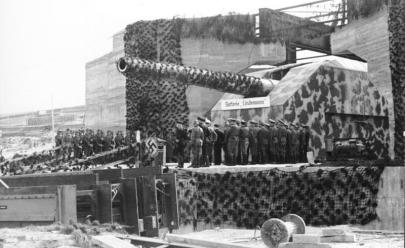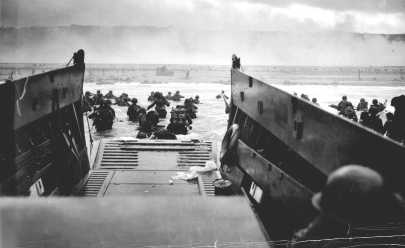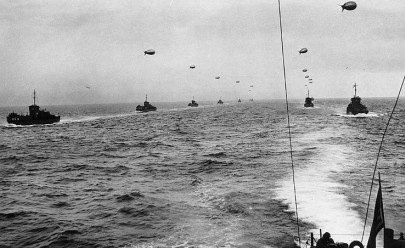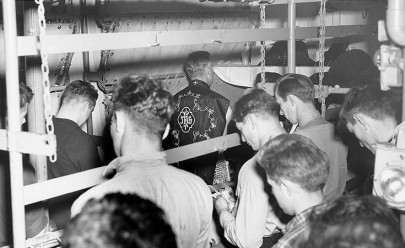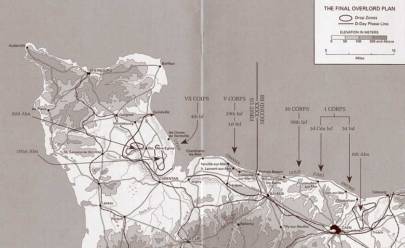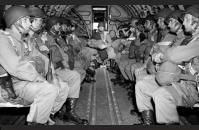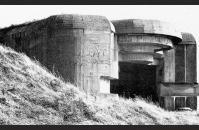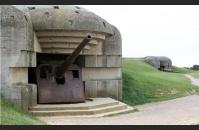D-DAY AT A GLANCE:
Image Gallery
D-Day (June 6, 1944)
Since Nazi Germany forced the Allies out of France to Great Britain in the spring of 1940, the Allies had been planning a cross-Channel assault to retake the continent and defeat Hitler’s Third Reich. By the spring of 1944 an elaborate plan—code-named Operation Overlord—was secretly in place. The Allies, led by American General Dwight Eisenhower, faced an enemy determined to keep them from landing successfully anywhere along the western European coastline. To ensure against such a landing, Hitler ordered Field Marshal Erwin Rommel to complete the Atlantic Wall—a 2,400-mile fortification made up of concrete bunkers, barbed wire, tank ditches, landmines, fixed gun emplacements, and beach and underwater obstacles. Many of these obstacles were specially designed to rip out the bottoms of landing craft or blow them up before they reached the shore. Others were made to trap soldiers on the beach where they would be exposed to intense gunfire from fortified positions.
On the eve of June 5, 1944, 175,000 men, a fleet of 5,000 ships and landing craft, 50,000 vehicles, and 11,000 planes sat in southern England, poised to attack secretly across the English Channel along a 50-mile stretch of the Normandy coast of France. This force, one of the largest armadas in history, represented years of rigorous training, planning, and supplying. It also represented a previously unknown level of cooperation between allied nations, all struggling for a common goal—the defeat of Nazi Germany. Because of highly intricate deception plans, Hitler and most of his staff believed that the Allies would be attacking at the Pas-de-Calais, the narrowest point between Great Britain and France.
In the early morning darkness of June 6, thousands of Allied paratroopers and glider troops landed silently behind enemy lines, securing key roads and bridges on the flanks of the invasion zone. As dawn lit the Normandy coastline the Allies began their amphibious landings, traveling to the beaches in small landing craft lowered from the decks of larger ships anchored in the Channel. They assaulted five beaches, code-named Utah, Omaha, Gold, Juno, and Sword. The bloodiest fighting occurred at Omaha, where the Americans suffered more than 2,000 casualties. By nightfall nearly all the Allied soldiers were ashore at a cost of 10,000 American, British, and Canadian casualties. Hitler’s vaunted Atlantic Wall had been breached in less than one day. The beaches were secure, but it would take many weeks before the Allies could fight their way out of the heavily defended Normandy countryside and almost a full year to reach and defeat Germany in the spring of 1945.
Operation Overlord was not just another great battle, but the true turning point of WWII in Western Europe. While the U.S. and Great Britain had earlier engaged the Axis powers on the periphery of the Europe (North Africa, Sicily, Italy), it was not until the invasion at Normandy that they brought on the beginning of the end for Hitler and his Nazis. Had the invasion failed (Eisenhower was prepared to read a statement over the radio taking full responsibility if Allied troops were driven from the beaches), Hitler would have been able to pull troops out of France to strengthen his Eastern Front against the encroaching Soviets. A second Allied invasion into France would have taken more than a year to mount. Hitler, meanwhile, would have further strengthened his Atlantic Wall, his newly developed V-1 flying bombs would have continued to rain down on England from launching pads across the Channel, and the Nazis’ Final Solution against European Jews might well have succeeded completely.
Download a printable version of this At A Glance
TAKE ACTION:


EDUCATION PROJECTS:
Student Travel – WWII Educational Tours
High school and college students, learn the leadership principles that helped win WWII on a trip to France or during a weeklong residential program in New Orleans. College credit is available, and space is limited.
See You Next Year! HS Yearbooks from WWII
Collected from across the United States, the words and pictures of these yearbooks present a new opportunity to experience the many challenges, setbacks and triumphs of the war through the eyes of America’s youth.
The Victory Gardens of WWII
Visit the Classroom Victory Garden Project website to learn about food production during WWII, find lesson plans and activities for elementary students, get tips for starting your own garden and try out simple Victory Garden recipes!
The Science and Technology of WWII
Visit our new interactive website to learn about wartime technical and scientific advances that forever changed our world. Incorporates STEM principles to use in the classroom.
Kids Corner: Fun and Games!
Make your own propaganda posters, test your memory, solve puzzles and more! Learn about World War II and have fun at the same time.


